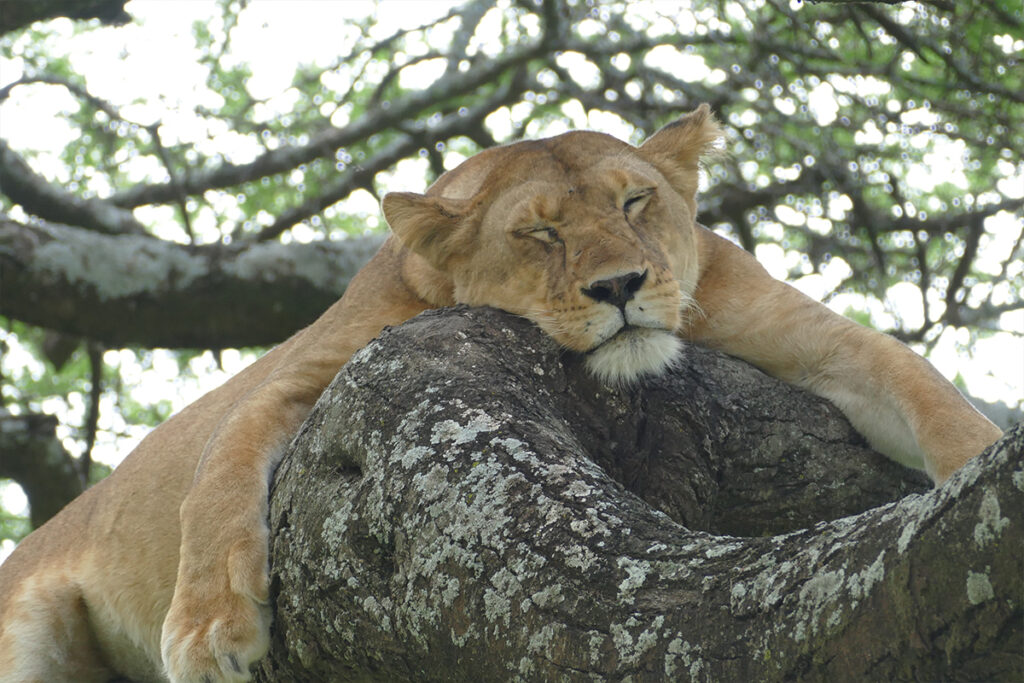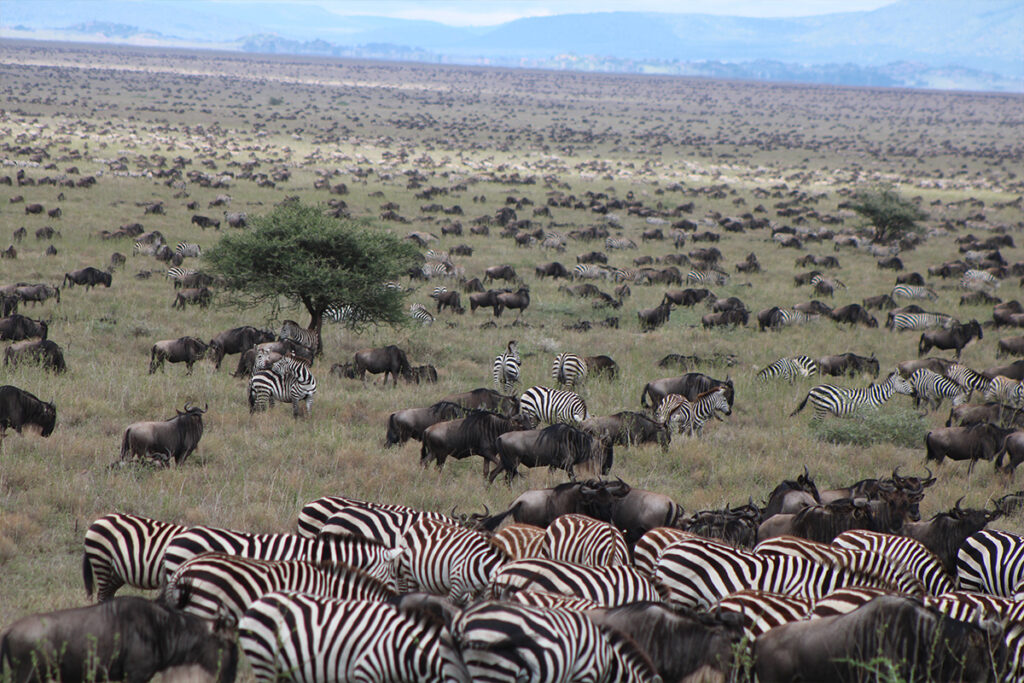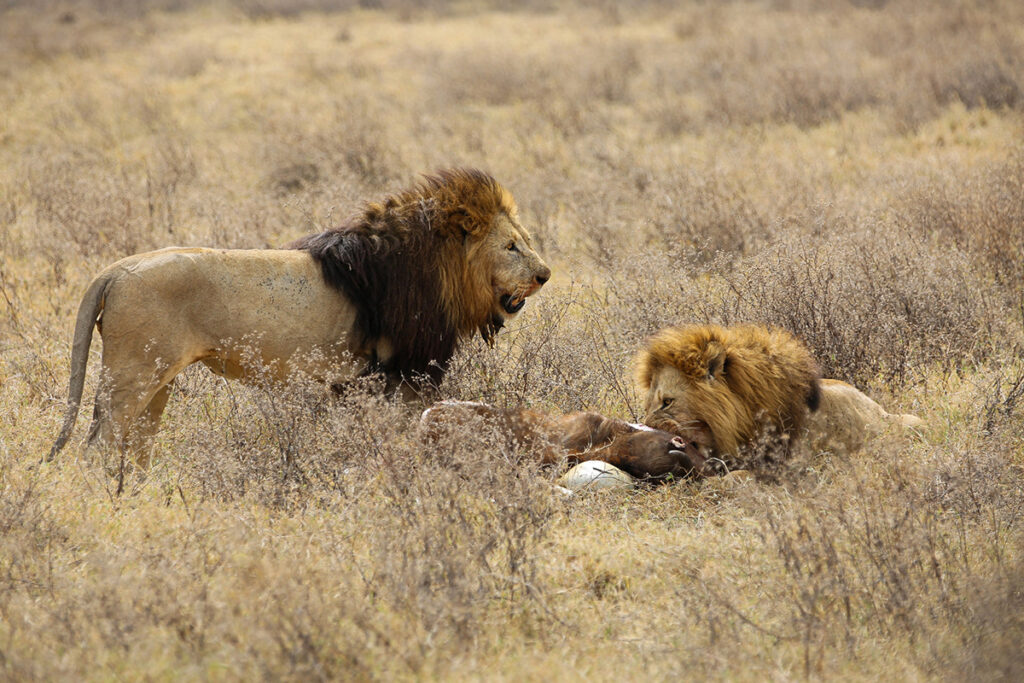Every year between January and March, over half a million wildebeest are born in the Serengeti. This incredible mass birthing event is one of nature’s most spectacular phenomena. Calving season is strategic, as synchronized births overwhelm predators, increasing each calf’s survival rate.
The Serengeti’s calving season has a rich history intertwined with the evolutionary success of the wildebeest. During this period, approximately 8,000 calves are born every day, leading to a dramatic increase in the population. This phenomenon, critical for the survival of the species, also attracts an influx of tourists keen to witness this natural wonder.

Calving Season in the Serengeti
Calving season in the Serengeti is a remarkable time from January to March. This period is when over 500,000 wildebeest calves are born, transforming the plains. Driven by instinct, large groups of pregnant wildebeest migrate to the southern Serengeti. The synchronized birthing is a defense strategy against predators. By having so many calves at once, they increase the chances of survival.
During calving season, the landscape is teeming with life. Baby wildebeest are extremely vulnerable but can stand and run within minutes of birth. This rapid development is crucial for evading predators like lions and hyenas. The calves stick close to their mothers, learning to navigate the dangers quickly. Life in the Serengeti is a constant balance of survival and growth.
The Serengeti’s calving season also significantly impacts other wildlife. Predators time their breeding to coincide with the calving season, ensuring there’s plenty of food available. According to the article, even birds benefit, feasting on afterbirths and insects disturbed by the herds. The entire ecosystem is interconnected, relying on the influx of young wildebeest for sustenance.
For tourists wanting to witness this spectacle, the best viewing spots vary yearly. However, the southern plains consistently offer great opportunities. Here is the article detailing the best spots to observe the Great Migration in 2025. Experiencing the calving season provides a deeper understanding of nature’s cycles, making it a must-see event.
Overview of the Phenomenon
The Serengeti’s calving season is a fascinating natural event. It begins in earnest around late January and extends through March. During this time, the Serengeti becomes a birthing ground for more than half a million wildebeest calves. Every day, around 8,000 new calves take their first breath, creating a staggering and awe-inspiring sight. The rapid birth rate helps the calves keep up with the migrating herd.
The timing of the calving season is not random. It aligns perfectly with the nutrient-rich grass that grows after the short rains. This abundance of food provides the essential nutrition the mothers need. Newborn calves rely on their mothers’ milk, rich in proteins and fats, to grow strong quickly. The synchronicity of nature’s elements at this time is truly extraordinary.
During this period, predators like lions, hyenas, and cheetahs are on high alert. They take advantage of the large number of vulnerable calves. However, the sheer number of births overwhelms the predators, ensuring many calves have a chance to survive. It’s a delicate balance of life and death, showcasing the raw power of nature. The sights and sounds of the Serengeti during calving season are unforgettable.
Besides wildebeest, other species like zebras and gazelles also give birth around this time. The entire ecosystem buzzes with new life and activity. According to the article, these synchronized births are crucial for maintaining the delicate balance in the Serengeti. Observing the calving season provides profound insights into the dynamics of the wild.
Ecological Significance of the Calving Season
The calving season in the Serengeti is crucial for maintaining the balance of the ecosystem. Each birth injects new life into the environment. The abundance of young wildebeest provides a stable food source for predators. This cyclical process helps sustain the ecological balance. It’s a vivid demonstration of interconnectedness in nature.
Moreover, the synchronized births help preserve the wildebeest population. Over half a million calves within a short span overwhelm predators, ensuring higher survival rates. This strategy is essential for the long-term viability of the species. Calves that survive contribute to the genetic diversity. It’s nature’s way of ensuring the fittest adapt and prosper.
- Provides food for predators
- Supports genetic diversity
- Helps maintain population balance
- Aids in nutrient cycling
The calving season also benefits the vegetation. Grazing by large herds enables nutrient cycling, which helps enhance soil fertility. This process stimulates the growth of new grass, benefiting herbivores. The nutrient transfer from animal waste to soil illustrates a sustainable loop. The ecosystem thrives due to these interdependencies.
Additional species, such as zebras and gazelles, also time their birthing around this season. This synchronized birthing leads to a period of intense biological productivity. The entire Serengeti thrives during this time. According to this post, observing these phenomena offers incredible insights into ecological dynamics. The spectacle showcases nature’s resilience and intricate design.
Challenges Faced During Calving Season
Calving season in the Serengeti is not without its challenges. Predators like lions, hyenas, and cheetahs wait for this time. The abundance of vulnerable calves is an opportune moment for them. The predators increase their hunting activities significantly. This puts immense pressure on the wildebeest and their young.
In addition to predators, weather conditions can be harsh. Heavy rains can turn the plains into muddy traps. Newborn calves often struggle in these conditions. The mud prevents them from moving quickly, making them easy targets. Even mothers find it hard to navigate the slippery terrain.
Diseases also pose a significant risk during calving season. Dense herds facilitate the rapid spread of infections. Calves, with their immature immune systems, are particularly vulnerable. A disease outbreak can lead to high mortality rates. Keeping the herds healthy is a constant battle.
Human activities add another layer of difficulty. Poaching, though reduced, still exists and impacts the wildebeest population. Additionally, habitat encroachment from farming and settlements disrupts their migration patterns. These interferences can have long-lasting effects on the ecosystem. Conserving the Serengeti is crucial for the survival of its wildlife.
Despite these challenges, the resilience of the wildebeest is remarkable. They adapt and overcome many obstacles each year. According to this post, the calving season continues to be a critical component of the Great Migration. Witnessing their perseverance is nothing short of inspiring. It highlights the extraordinary endurance of these animals in their natural habitat.
Impact on the Serengeti Wildlife and Predators
The calving season in the Serengeti creates a ripple effect throughout its ecosystem. The influx of young wildebeest significantly influences the food chain. Predators find themselves with abundant prey, altering their hunting strategies. Lions, specifically, adjust their pride structures to deal with increased availability. The entire hierarchy in predator communities shifts during this time.
However, it’s not just the predators that benefit. Scavengers like vultures and jackals also find themselves with plenty of food. The remains from predator kills are vital for these scavengers. It ensures their survival during the calving season. Thus, they form an essential link in the ecosystem’s balance.
This seasonal change impacts herbivores as well. With the migration of wildebeest, grazing patterns adjust accordingly. Other herbivores, like zebras, adapt their activities for maximum resource sharing. Such competition can lead to temporary shortages. Animals may thus expand their grazing areas.
Surprisingly, the calving season aids in preserving vegetation. Large herds contribute to grass regrowth by trampling on older plants. This natural pruning promotes fresh, nutrient-rich growth afterward. The cyclical nature of feeding and regrowing is vital for maintaining biodiversity. Plants benefit from the nutrient recycling process happening simultaneously.
Overall, the calving season is instrumental in shaping the Serengeti. Each species, from the top predator to the smallest bug, plays its part. This creates a network of interdependence essential for the ecosystem’s health. It is a vivid example of how a single season can affect countless lives. Observing these interactions enriches our understanding of nature.
Observing Calving Season: Tips for Tourists
Visiting the Serengeti during calving season offers a unique wildlife experience. January to March is the peak time to witness the birth of thousands of calves. Booking early is essential, as accommodations fill up quickly. Ensure you choose a guided tour with an experienced ranger. They can maximize your wildlife viewing opportunities.
Staying in a lodge or campsite near the southern Serengeti is ideal. This location places you in proximity to the calving grounds. Local guides can offer insights into the ecosystem, enhancing your understanding. It’s advised to have binoculars for clear sightings of the wildlife. Remember to pack appropriately for variable weather conditions.
Capture memories with photography, but also take time to enjoy the spectacle. Early morning and late afternoon are the best times for optimal lighting. Silence is vital to avoid disturbing the animals. Respecting the wildlife ensures their safety and comfort. Following these guidelines allows you to witness nature undisturbed.
- Book accommodations and tours early
- Choose locations near calving grounds
- Bring binoculars for better viewing
- Consider weather-appropriate clothing
Be mindful of the Serengeti’s fragile ecosystem. Littering and off-road driving can damage the habitat. Support conservation efforts by choosing eco-friendly lodges. Resources preserved today ensure experiences remain for future generations. Responsible tourism sustains the ecosystem and wildlife.
Understanding and preparation lead to an unforgettable adventure. Experiencing the calving season offers insights into the circle of life. Be ready to witness the elegance and drama that the Serengeti provides. According to this post, witnessing the calving season adds more depth to your safari trip. It’s a journey filled with breathtaking moments.

Frequently Asked Questions
Explore the fascinating dynamics of the Serengeti’s calving season. Discover intriguing aspects that impact the entire ecosystem and enrich wildlife experiences.
1. Why do wildebeests give birth during the same period?
Wildebeests time their births to occur in a synchronized manner for several reasons. One main reason is to reduce predation by overwhelming predators with a vast number of young. By having thousands of calves born in a short time, it boosts the chances of individual survival as predators can’t possibly consume them all. This synchronized birthing season is a natural defense mechanism.
Additionally, the timing coincides with the rains, which lead to lush grass growth. This ensures that lactating mothers have abundant nutrition to nourish their calves. By optimizing the timing of births with peak food availability, wildebeests enhance calf growth and survival rates. This synergy between birth timing and environment showcases nature’s precise strategy for survival.
2. What role do predators play during calving season?
During the calving season, predators such as lions and hyenas increase their activity. This period offers them a plentiful supply of prey as they take advantage of the vulnerable wildebeest calves. The abundance of prey affects predator behaviors, such as hunting patterns and feeding habits, making it a critical time for them.
While predators play a natural role in controlling wildebeest populations, their increased presence adds to the harsh challenges the young face. However, not all calves fall prey, and this predation helps maintain a balanced ecosystem. This dynamic interaction between predator and prey is integral to the Serengeti’s ecological health and diversity.
3. How does calving season affect the Serengeti’s vegetation?
During calving season, the sheer number of wildebeests has a significant impact on the Serengeti’s vegetation. The grazing during this time helps control grass growth, preventing it from becoming too tall or dense. This grazing pressure contributes to the cycle of grass regrowth, keeping the ecosystem balanced.
The constant movement of the herds also helps with seed dispersion, encouraging plant diversity. Trampled areas see increased nutrient recycling as animal droppings fertilize the soil. This intricate relationship between animals and vegetation maintains the ecological equilibrium and supports a wide range of species in the Serengeti.
4. What challenges do wildebeests face during the calving season?
Wildebeests encounter numerous challenges during calving season, particularly from predators. As many vulnerable calves are born, lions, hyenas, and other predators step up their hunting efforts. This natural predatory pressure is one of the significant threats to newly born wildebeest calves during this season.
Weather conditions pose another set of challenges. Heavy rains can create muddy conditions, making movement difficult for both calves and adults. Calves are more prone to exhaustion and injury, reducing their chance of survival. These challenges highlight the constant battle for survival in the wild.
5. How can tourists best experience the calving season?
To fully appreciate the calving season, tourists should plan their visits between January and March. Choosing a safari tour led by experienced guides can enhance the experience, offering in-depth insights into the behavior and dynamics of the herds. Staying in southern Serengeti lodges ensures proximity to the action.
Tourists are advised to pack appropriately, considering variable weather and terrain. Observing quietly and respectfully minimizes disruption to the wildlife. Following these tips can maximize the chances of witnessing the awe-inspiring events of the calving season, ensuring a memorable adventure for nature enthusiasts.



